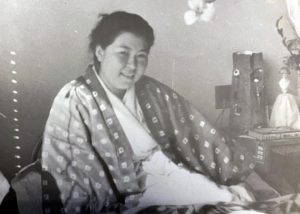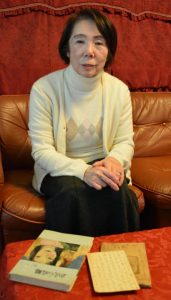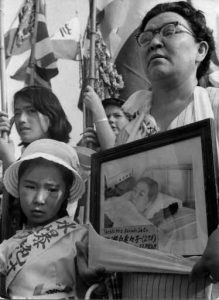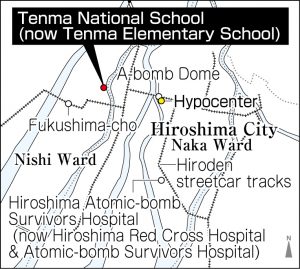Striving to fill voids in Hiroshima, evidence of victims remains—Deaths from leukemia, Part 5: Mother’s journal
Mar. 25, 2023
Mami Kimura, 67, a resident of Tagawa City in Fukuoka Prefecture, has treasured a certain book since she was a child. The book, Kaeranu Tsuru (in English, ‘The crane that will not return’), was published in 1961 based on a journal written by Ms. Kimura’s mother, Nanako Seto, who was confined to bed with myeloid leukemia and died when Ms. Kimura was only three years old.
“I have very few memories of my mother, but I vaguely remember hugging her around the neck just before she died, at my grandmother’s urging,” Ms. Kimura said. However, she learned much about her mother from the book, which she started reading at the age of 10.
Nanako was living with her now-deceased mother, Miyako Hayashida, and younger brother in the area of Fukushima-cho (now part of Hiroshima’s Nishi Ward) during the war. On August 6, 1945, the day of the atomic bombing, 12-year-old Nanako experienced the bombing at Tenma National School (present-day Tenma Elementary School, in the city’s Nishi Ward), about 1.2 kilometers from the hypocenter, suffering a wound to her face.
Nanako’s father was killed in the war. Miyako, her mother, raised her two children by selling Chinese-style noodles from a food stand on the street and peddling odds and ends. Watching her mother struggle, Nanako quit the girls’ school and became a hairdresser, opening a small beauty salon in Hiroshima’s present-day Nishi Ward. She married in 1953, and her oldest daughter, Mami, was born in February 1956.
“Please forgive your sick mother”
However, in 1957, Nanako was laid low by anemia and diagnosed with leukemia. She was admitted to the Hiroshima Atomic-bomb Survivors Hospital (present-day Hiroshima Red Cross Hospital & Atomic-bomb Survivors Hospital, in the city’s Naka Ward), starting in November of that year. In her hospital room, she wrote numerous passages in her journal about her feelings for her only daughter, from whom she was then separated. “Mami, please forgive your sick mother,” reads an entry dated December 14, 1958.
Other entries read, “I have not seen Mami for two days, and I miss her already” (Jan. 15, 1958)”; “It’s been a long while since I played with Mami all day. She said, ‘Mommy, you go beddy-bye once more, and daddy, mommy, and Mami will go together to the Fukuya Department Store,’ which made me cry. I pray that day will come as soon as possible” (Jan. 12, 1959); “I want to get better by the time of Mami’s kindergarten entrance ceremony” (Jan. 14, 1959).
On April 9, 1959, Miyako visited Nanako’s hospital room to show her Mami in a school uniform for the entrance ceremony Nanako was unable to attend due to her deteriorating health. Nanako looked delighted and sang with Mami the children’s song “Yuyake Koyake” (‘Sunset’), straining her already failing voice.
Marched with photo of Nanako
Nevertheless, Nanako died the following morning, while repeatedly whispering “my dear Mami” as she was dying. She was 26 years old.
Two years later, Miyako published Nanako’s journal and her own personal account in the book Kaeranu Tsuru. In her account, Miyako wrote, “Although our lives have been rewritten, I hope this will at least contribute in some way to peace.” Every year in August, Miyako would participate in the Peace March in Hiroshima together with Mami, holding a photograph of Nanako in her hand as they walked.
At first, Mami took part in the march in a baby carriage wheeled around by Miyako. It was not long before she joined the activities of the Hiroshima Paper Crane Club, a children’s peace organization. Mami said, “My grandmother had connections with the people in the club, so it was natural for me to join.” She had been involved in their fund-raising drive for the preservation of the Atomic Bomb Dome and other activities since elementary school.
Mami later married a man from Fukuoka Prefecture and raised five children, retreating from her participation in peace activities. However, her mother’s words became more real. “I thought about how I would feel if I died and left my children behind. It must have been very hard for my mother not to be able to live despite wanting to,” she said.
She has given a copy of the book to her children, who have by now left home and are living elsewhere. In May later this year, the summit meeting of the G7 (Group of Seven industrialized nations) will be held in her hometown of Hiroshima. Once again, she reflects deeply about her mother’s feelings. “Unlike disease, war and nuclear devastation can be prevented based on human desire. I want the G7 leaders in Hiroshima to have the ability to imagine what would happen if nuclear weapons are ever used again,” said Ms. Kimura.
(Originally published on March 25, 2023)
“I have very few memories of my mother, but I vaguely remember hugging her around the neck just before she died, at my grandmother’s urging,” Ms. Kimura said. However, she learned much about her mother from the book, which she started reading at the age of 10.
Nanako was living with her now-deceased mother, Miyako Hayashida, and younger brother in the area of Fukushima-cho (now part of Hiroshima’s Nishi Ward) during the war. On August 6, 1945, the day of the atomic bombing, 12-year-old Nanako experienced the bombing at Tenma National School (present-day Tenma Elementary School, in the city’s Nishi Ward), about 1.2 kilometers from the hypocenter, suffering a wound to her face.
Nanako’s father was killed in the war. Miyako, her mother, raised her two children by selling Chinese-style noodles from a food stand on the street and peddling odds and ends. Watching her mother struggle, Nanako quit the girls’ school and became a hairdresser, opening a small beauty salon in Hiroshima’s present-day Nishi Ward. She married in 1953, and her oldest daughter, Mami, was born in February 1956.
“Please forgive your sick mother”
However, in 1957, Nanako was laid low by anemia and diagnosed with leukemia. She was admitted to the Hiroshima Atomic-bomb Survivors Hospital (present-day Hiroshima Red Cross Hospital & Atomic-bomb Survivors Hospital, in the city’s Naka Ward), starting in November of that year. In her hospital room, she wrote numerous passages in her journal about her feelings for her only daughter, from whom she was then separated. “Mami, please forgive your sick mother,” reads an entry dated December 14, 1958.
Other entries read, “I have not seen Mami for two days, and I miss her already” (Jan. 15, 1958)”; “It’s been a long while since I played with Mami all day. She said, ‘Mommy, you go beddy-bye once more, and daddy, mommy, and Mami will go together to the Fukuya Department Store,’ which made me cry. I pray that day will come as soon as possible” (Jan. 12, 1959); “I want to get better by the time of Mami’s kindergarten entrance ceremony” (Jan. 14, 1959).
On April 9, 1959, Miyako visited Nanako’s hospital room to show her Mami in a school uniform for the entrance ceremony Nanako was unable to attend due to her deteriorating health. Nanako looked delighted and sang with Mami the children’s song “Yuyake Koyake” (‘Sunset’), straining her already failing voice.
Marched with photo of Nanako
Nevertheless, Nanako died the following morning, while repeatedly whispering “my dear Mami” as she was dying. She was 26 years old.
Two years later, Miyako published Nanako’s journal and her own personal account in the book Kaeranu Tsuru. In her account, Miyako wrote, “Although our lives have been rewritten, I hope this will at least contribute in some way to peace.” Every year in August, Miyako would participate in the Peace March in Hiroshima together with Mami, holding a photograph of Nanako in her hand as they walked.
At first, Mami took part in the march in a baby carriage wheeled around by Miyako. It was not long before she joined the activities of the Hiroshima Paper Crane Club, a children’s peace organization. Mami said, “My grandmother had connections with the people in the club, so it was natural for me to join.” She had been involved in their fund-raising drive for the preservation of the Atomic Bomb Dome and other activities since elementary school.
Mami later married a man from Fukuoka Prefecture and raised five children, retreating from her participation in peace activities. However, her mother’s words became more real. “I thought about how I would feel if I died and left my children behind. It must have been very hard for my mother not to be able to live despite wanting to,” she said.
She has given a copy of the book to her children, who have by now left home and are living elsewhere. In May later this year, the summit meeting of the G7 (Group of Seven industrialized nations) will be held in her hometown of Hiroshima. Once again, she reflects deeply about her mother’s feelings. “Unlike disease, war and nuclear devastation can be prevented based on human desire. I want the G7 leaders in Hiroshima to have the ability to imagine what would happen if nuclear weapons are ever used again,” said Ms. Kimura.
(Originally published on March 25, 2023)











